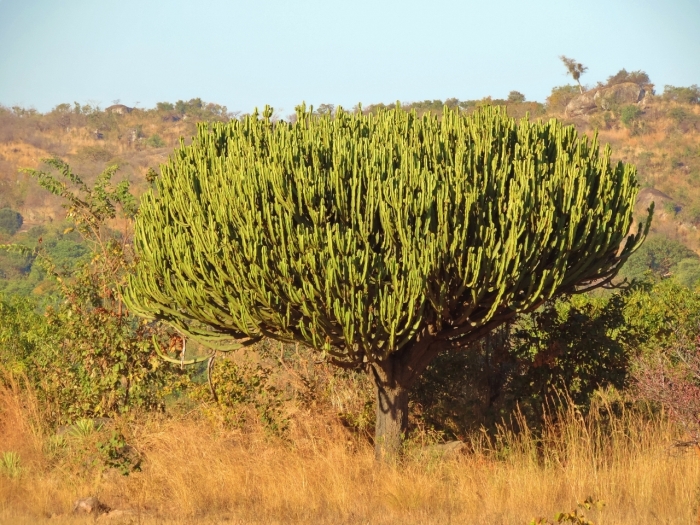Candelabra Tree
(Euphorbia ingens)
Candelabra Tree (Euphorbia ingens)
/
/

i_c_riddell
CC BY 4.0
Image By:
i_c_riddell
Recorded By:
Copyright:
CC BY 4.0
Copyright Notice:
Photo by: i_c_riddell | License Type: CC BY 4.0 | License URL: http://creativecommons.org/licenses/by/4.0/ | Rights Holder: i_c_riddell | Publisher: iNaturalist | Date Created: 2019-07-07T16:06:45-07:00 |


























Estimated Native Range
Summary
Euphorbia ingens, commonly known as Candelabra Tree, is an evergreen succulent tree native to dry, rocky outcrops and slopes in Southern Africa. It can reach heights of 6–8 meters with a thick, succulent trunk and branches that resemble the shape of a candelabra. The branches are green and cylindrical, giving the plant a distinctive silhouette. The small, greenish-yellow flowers are inconspicuous and appear on the ridges of the upper branches, typically blooming from autumn to winter. The fruit is a three-lobed capsule that starts red and turns purple when ripe.
The Candelabra Tree is valued for its sculptural form and minimal water needs, making it suitable for xeriscaping and as a focal point in rock gardens and arid landscape designs. It is also used as an indoor plant in large spaces. This species is drought-tolerant and thrives in full sun, requiring well-drained soil. While it has few pests, the plant’s toxic latex can be an irritant, and care should be taken when handling. In cultivation, it is important to avoid overwatering to prevent root rot.CC BY-SA 4.0
The Candelabra Tree is valued for its sculptural form and minimal water needs, making it suitable for xeriscaping and as a focal point in rock gardens and arid landscape designs. It is also used as an indoor plant in large spaces. This species is drought-tolerant and thrives in full sun, requiring well-drained soil. While it has few pests, the plant’s toxic latex can be an irritant, and care should be taken when handling. In cultivation, it is important to avoid overwatering to prevent root rot.CC BY-SA 4.0
Plant Description
- Plant Type: Tree, Succulent
- Height: 20-25 feet
- Width: 30-40 feet
- Growth Rate: Slow
- Flower Color: N/A
- Flowering Season: Fall, Winter
- Leaf Retention: Evergreen
Growth Requirements
- Sun: Full Sun
- Water: Low
- Drainage: Medium
Common Uses
Bee Garden, Bird Garden, Deer Resistant, Drought Tolerant, Low Maintenance, Rabbit Resistant, Rock Garden
Natural Habitat
Native to dry, rocky outcrops and slopes in Southern Africa
Other Names
Common Names: Cactus Euphorbia, Cactus Spurge, Naboom, Kaktus-Wolfsmilch
Scientific Names: , Euphorbia ingens, Euphorbia similis,
GBIF Accepted Name: Euphorbia ingens E.Mey. ex Boiss.